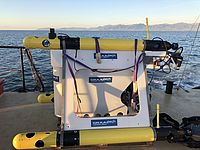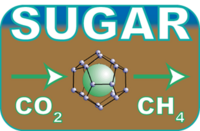Closed DSM Projects
The DeepSea Monitoring group has been involved in the following national and international research projects:
REEBUS
The project REEBUS was aiming for understanding the role of ocean eddies in the carbon pump of eastern boundary upwelling system. Seven work-packages worked side by side on different aspects of ocean eddies, such as eddy formation and stability, physical mixing, carbon uptake via phytoplankton at the surface, sinking of particles and their decomposition and particle flux to the seafloor. The DSM group was involved into spatial mapping of deepsea regions and correlation of seafloor properties (morphology, benthic fauna) to geochemical in-situ measurements and machine learning algorithms were developed for extrapolation of geochemical properties into wider areas.
See also ebus-climate-change.de

BASTA
The European research project BASTA (Boost Applied munition detection through Smart data inTegration and AI workflows) was coordinated by our group with the participation of the Marine Institute Flanders (VLIZ), the sotware developer EGEOS GmbH and the Belgian surveying service provider G-Tec SA. It was funded by the EU's European Maritime and Fisheries Fund (EMFF) in the Blue Labs program. The project aimed at advancing the approach for munition detection both on a local and a larger scale. It seeked to advance data acquisition through ultra-high-resolution 3D sub-bottom profiling (SBP) and intelligent autonomous underwater vehicle (AUV) based magnetic mapping as part of an adaptive and iterative survey approach. In addition, it fostered sustainable use of survey and historical data within a multi-sensor database.
See also basta-munition.eu
Digital Earth
Digital Earth has been strategically initiated by all eight centres of the Helmholtz research field Earth and Environment (E&E) and is coordinated by our group. The project aimed for advances in the Earth system understanding through better integration of data and knowledge from the different Earth science disciplines and Earth compartments. Improvement in this field strongly depends on our capabilities of dealing with fast growing multi-parameter data and on our effort employing Data Science methods, adapting new algorithms and developing digital workflows tailored to specific scientific needs.
See also digitalearth-hgf.de

COMPASS
COMPASS (Control of an Operational Mining Path Through an Auto-Adaptive Steering System) was funded by the MarTERA partners Flanders Innovation & Entrepreneurship (VLAIO) and German Federal Ministry of Economic Affairs and Energy (BMWi) and co-funded by the European Union. The aim was to develop an autonomous and adaptive steering system for seabed nodule mining. The system determines the most operationally and environmentally efficient mining path seabed mining vehicle (MV), while guaranteeing safe execution, integrating forecasted hydrodynamic and sediment transport data, optimal maneuverability and production efficiency.
See also martera.eu/projects/compass
JPIO Mining Impact - Environmental Impacts and Risks of Deep-Sea Mining
This MiningImpact phase followed up on the results of the JPI Oceans pilot action on "Ecological Aspects of Deep-Sea Mining" which terminated in late December 2017 (see results here). While the initial MiningImpact phase investigated experimental and rather small-scale disturbances of the seafloor over decadal timescales, the second part independently studied and comprehensively monitored in real time the environmental impact of an industrial trial to mine manganese nodules on the seafloor conducted simultaneously and independently by the Belgian contractor DEME-GSR in the Belgian and German licence area in the Clarion-Clipperton-Zone.
See also miningimpact.geomar.de
ROBUST
In the ROBUST project a fully autonomous underwater vehicle was developed, capable of hovering and grasping objects with a robotic arm. Additionally equipped with a Multibeam Echosounder, a Stereo Camera System and a Laser Scanner, it is capable of autonomously exploring vast terrains and analyzing individual resource deposits like manganese nodules.
A device was developed to allow Laser Induced Breakdown Spectroscopy (LIBS) in situ, making it possible to analyze materials without bringing them to the surface.
See also
https://www.youtube.com/watch?v=PHRMEDkoikg
eu-robust.eu
UDEMM
In the UDEMM project, extensive studies were made in order to analyse marine munition dumpsites regarding their content, state of deposition on the seafloor, release of explosive-type compounds and their uptake into the environment. The research inside the marine munition dumpsite ‘Kolberger Heide’ shows that it contains a very high number of marine munition objects in close contact to marine fauna and flora and environmental contamination is an issue.
A guideline was released on how monitoring of affected sites should be performed and how methods, such as hydroacoustic and optical mapping, seafloor classification, geochemical TNT measurements and biomonitoring are correctly used for such analyses.
Also see udemm.geomar.de
ENVRI PLUS
ENVRIplus was a cluster project supporting a development and integration of the major European Environmental and Earth System RIs. The DeepSea Monitoring group participated in the ENVRIplus Methane scientific cruise in April 2019, undertaken in the Romanian sector of Black Sea coupling different methodologies for quantifying marine methane transfer from the sediment to the atmosphere. A joint monitoring strategy for methane quantification was developed. Both in situ measurements and onshore analyses from collected samples were carried out.
See also
www.envriplus.eu/wp-content/uploads/2015/08/Press-Release_Methane_cruise_ENVRIplus.pdf
JPIO Mining Impact
- Ecological Aspects of Deep-Sea Mining
The JPIOceans project ‘MiningImpact’ aimed to assess the long-term impacts of polymetallic nodule mining on the deep-sea environment. Core to the project have been three 2015 marine research campaigns, conducted in the CCZ and the DISCOL Areas of the Pacific Ocean. The group was strongly involved in AUV-based image and hydroacoustic mapping, lander deployments and image database issues. See results here
See also miningimpact.geomar.de
MIDAS
The MIDAS project - Managing Impacts of Deep-seA reSource exploitation - was a multidisciplinary research programme investigating the environmental impacts of extracting mineral and energy resources from the deep-sea environment. This included the exploitation of materials such as polymetallic sulphides, manganese nodules, cobalt-rich ferromanganese crusts, methane hydrates and the potential mining of rare earth elements.
See also eu-midas.net
SUGAR III
The third phase of the BMBF/BMWI-funded “Submarine Gas Hydrate Reservoirs” aimed to commercialize techniques for monitoring and quantifying free gas release.
See also sugar-projekt.de/sugar
CAGE & MOCA
CAGE and MOCA focused on methane release in the Arctic offshore Svalbard, and the group was involved as an affiliated researcher (CAGE) and external partner (MOCA). The projects were run by the University of Tromsoe and NILU in Norway, respectively. We conducted hydroacoustic analyses in CAGE and MOCA to quantify the amount of free gas released from several sites at the shelf and slope offshore PKF as well as at pockmarks at Vestnesa Ridge. Further we supported the projects with our geochemical expertise and technology to measure methane in the water column and at the sea surface.


![[Translate to English:] Reebus](/fileadmin/_processed_/a/3/csm_reebus-logo_c59e8eb40d.png)





![[Translate to English:] Credits: Jana Ulrich](/fileadmin/_processed_/9/4/csm_UDEMM_598e401731.jpg)







